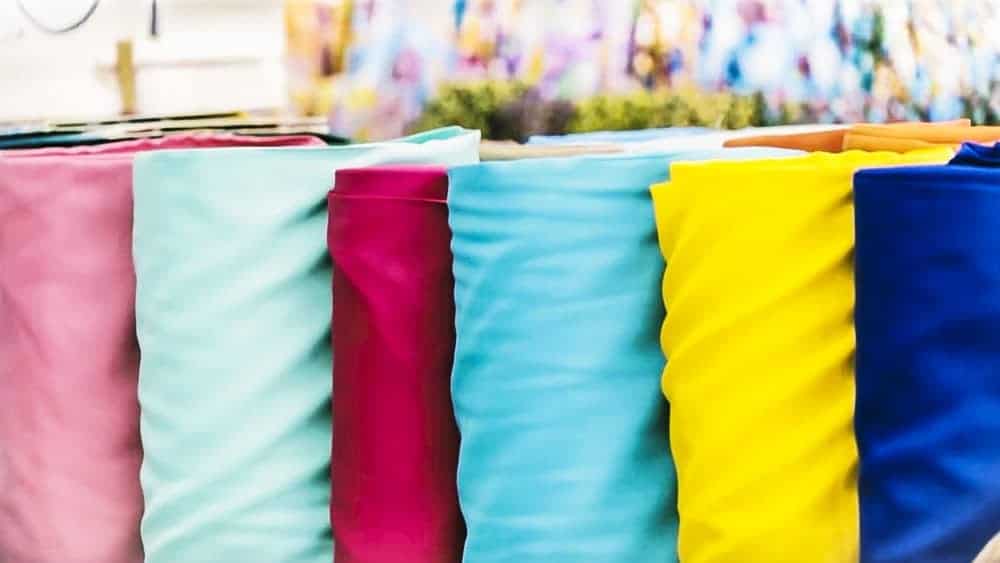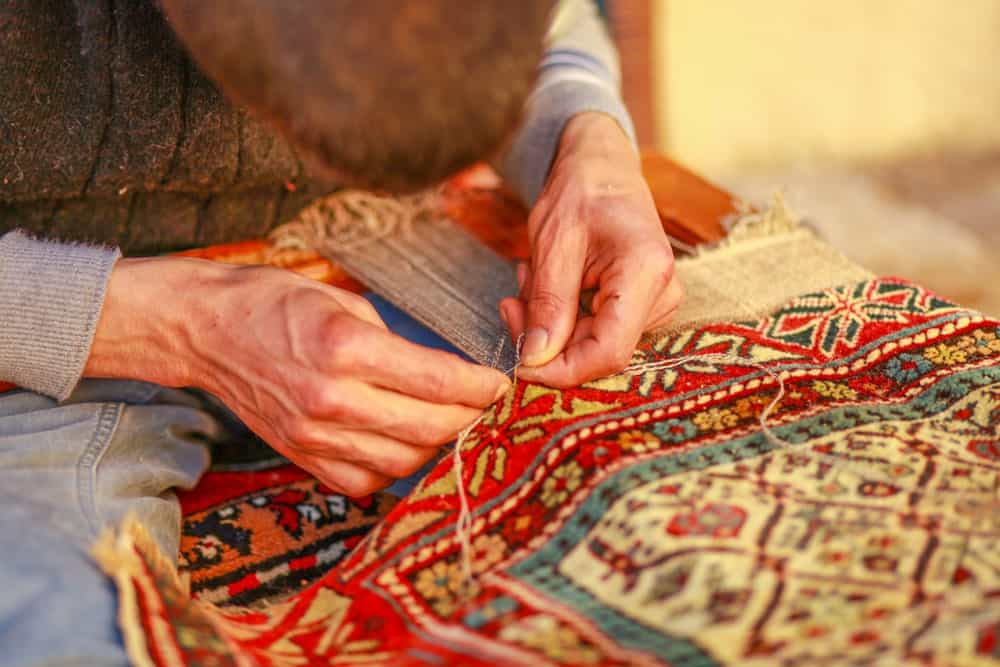Interested in Learning How to Sew? Learn about all of the different types of stitches available to be used in hand sewing, embroidery, and machine sewing.

I grew up in a family of crafters. My dad carves amazing figurines out of wood and I spent many evenings relaxing and watching television as a kid while my mom sat in her recliner and crocheted. She made everything from blankets to doilies to toys for me. When I got married, I inherited a great seamstress.
My mother-in-law made masks for us when COVID-19 struck and I call her up whenever my daughter or son rips a hole in their clothes. Having family members well versed in sewing, crocheting, and knitting is a lifesaver. These are valuable skills and it is interesting to learn more about all of the types of stitches that are out there.
Some are unique to hand stitching, embroidery, or sewing machines, while others are found in all three methods of sewing. Read on for ideas and easily look up each stitch on YouTube to find tutorials.
Contents
- Hand stitching
- Embroidery
- Sewing Machine Stitches
- Straight Stitch
- Reverse Straight Stitch
- Basting Stitches
- Satin Stitch
- Zigzag Stitch
- Stretch Stitch
- Edge Stitching
- Rolled Edge Stitch
- Triple Straight Stitch
- Coverstitch
- Buttonhole Stitch
- Blind Hem Stitch
- Scallop Stitch
- Shell Tuck Stitch
- Overcasting Stitch
- Insertion Stitch
- Ladder Stitch
- Multi-step Zigzag Stitch
- Overlock Stitch
- Lock Stitch
- Decorative Stitches
- FAQs
Hand stitching

Hand stitching is the most basic form of sewing. It is generally done with a simple needle and thread and stitch formation is done by hand. The most common uses for hand sewing are to mend garments, stuffed animals, and other objects made from fabric. There are many types of stitches to learn and choose from, here are a few to look into when planning to hand stitch.
Straight/Running Stitch

The most basic sewing stitch type, the running/straight stitch is made by inserting the needle from the backside upwards and then inserting the needle back down through the fabric and repeating.
Basting/Tacking Stitch

The basting stitch, or tacking stitch, is very similar to the straight stitch, but the stitches are longer (usually between 1/4 inch and 1/2 inch. These stitches can be straight or slanted. These can be used as a temporary stitch or to hold a seam.
Backstitch
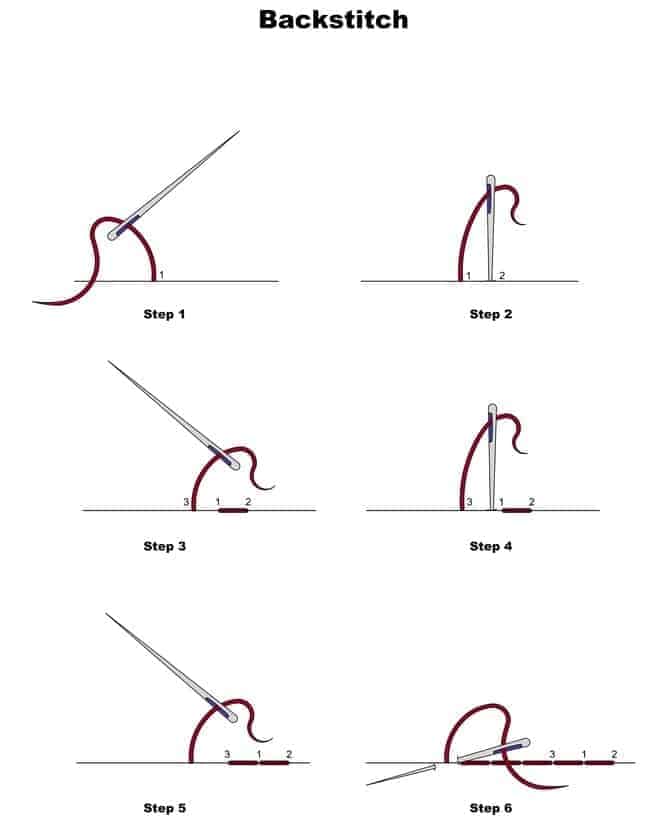
Before sewing machines rose to prominence, the backstitch was the stitch used for sewing clothes. This stitch is simple, strong, and reliable.
Catch Stitch
The catch stitch, also known as the cross-stitch, is used to finish hems so that they will not fray. It can also be used to tack facing invisibly.
Slip Stitch
Also known as the blind stitch, the slip stitch is the most common stitch used for hems. It looks very clean when done correctly and can be invisible.
Blanket Stitch

Used to sew the eyelets of buttonholes, the blanket stitch is also known as the buttonhole stitch. It can enclose the raw edges of heavy fabrics in a decorative way.
Fell Stitch
An applique stitch, the fell stitch is used when one layer of fabric is stitched to another. It is a strong stitch that can move like a hinge. It’s often used for installing linings.
Overcast Stitch
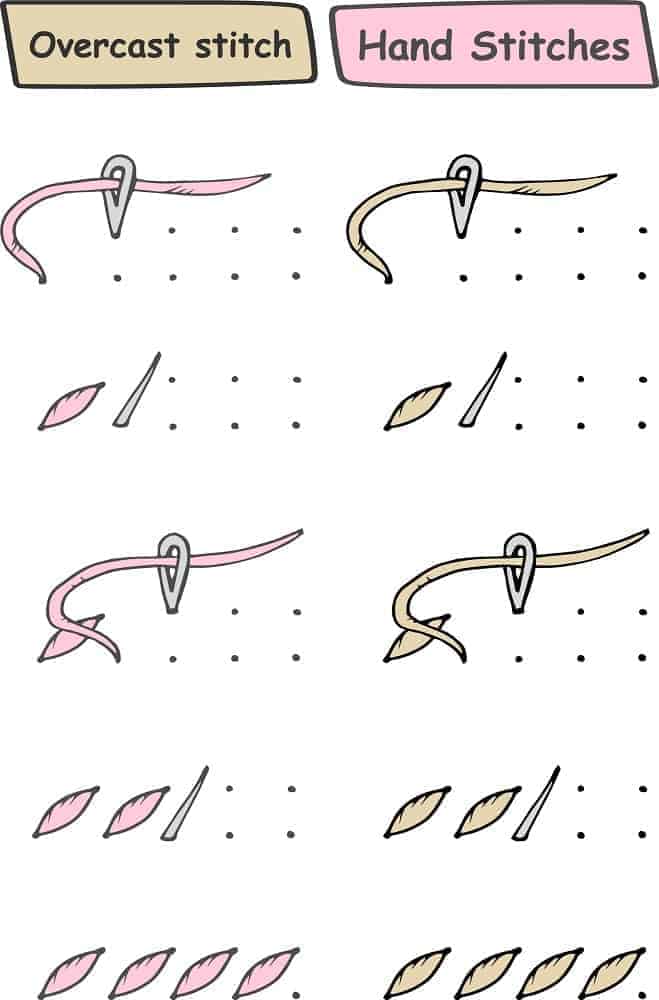
The overcast stitch secures the edges of the fabric to prevent unraveling.
Whip Stitch
Used in both sewing and crocheting, the whip stitch works well to sew together two pieces of material with flat edges. When used in crocheted pieces, it’s almost invisible. The whip stitch can be used in quilting, closing pillows and cushions, and making garments.
Embroidery
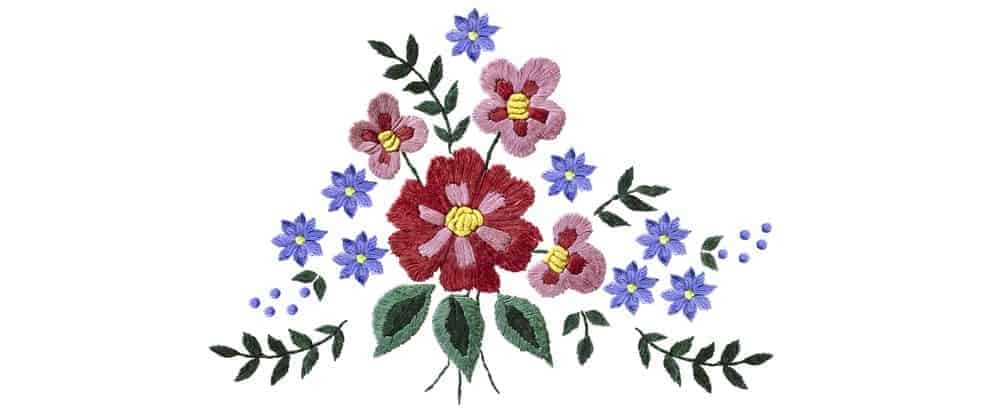
Embroidery is an intricate craft that creates beautiful designs on fabric by using yarn or thread and a needle. People can create their own patterns or use ready-made designs or stitch patterns. There are many types of stitches used in embroidery and learning more about these stitches will help you become faster and also better at creating your own designs. Learning all of the sewing stitches may sound like a difficult task, but with a little work, you will see how easy embroidery can be. Here is a look at some basic embroidery stitches.
Running Stitch
The easiest stitch, the running stitch is used for both mending and embroidery. It is also known as a straight stitch and is normally used to create the outline of an embroidery design.
Back Stitch
A thin-line stitch, the back stitch is normally used to outline a design before filling it in with another stitch. It also serves as a base to several composite stitches and is used to add fine detail to designs.
Stem Stitch

Another easy stitch, the stem stitch is great for beginners. It can create the outline of many embroidery stitches and can be used for curved or straight lines.
Split Stitch
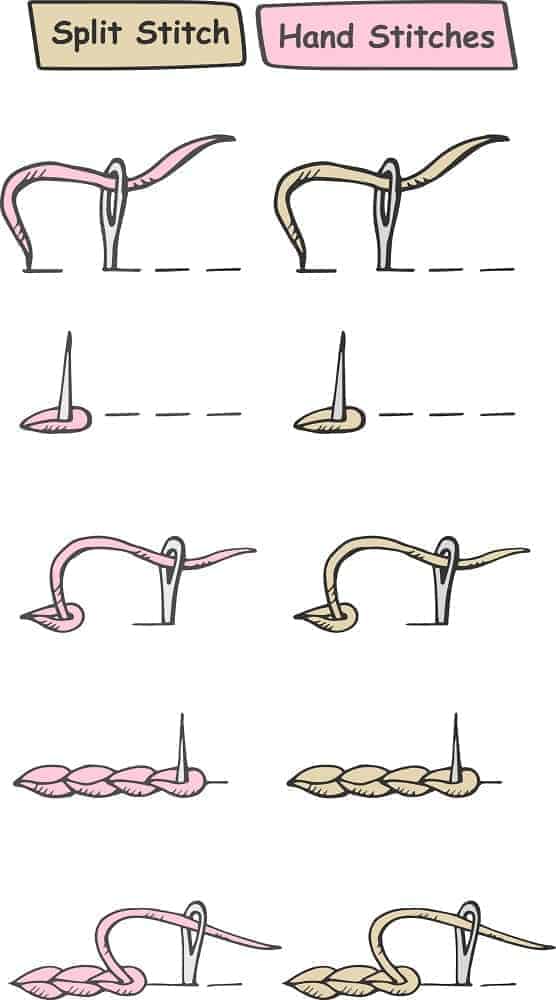
Giving the appearance of a mini-chain stitch when done repeatedly, the split stitch is a basic embroidery stitch. It is commonly used for creating delicate lines and curves. The split stitch can also be used as a fill stitch.
Satin Stitch
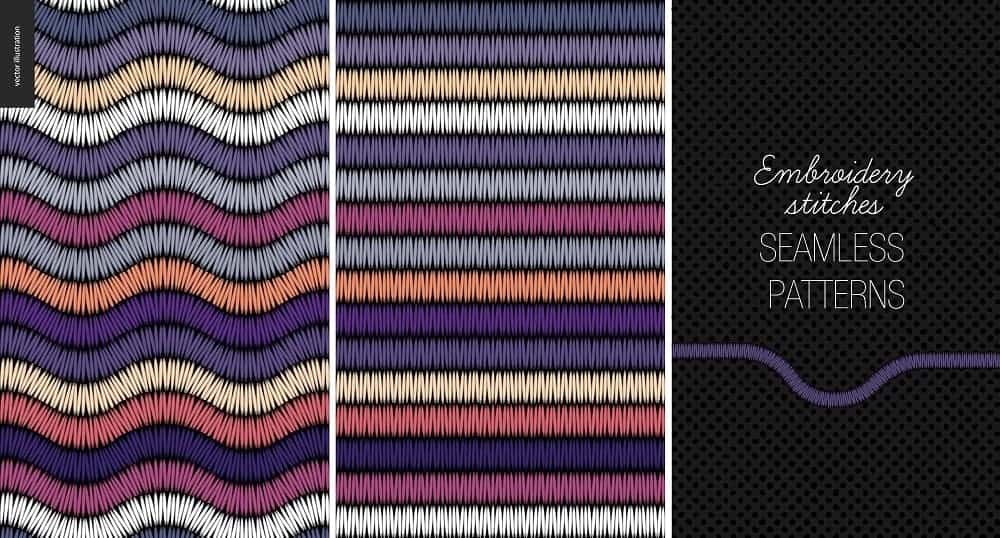
If your embroidery needs texture, use your needle and thread to create the satin stitch. This easy stitch can cover designs, such as a leaf, and leave a smooth-looking appearance. Many who embroider first create an outline using one of the straight stitches and then use the satin stitch as a fill stitch to complete the interior.
French Knot Stitch
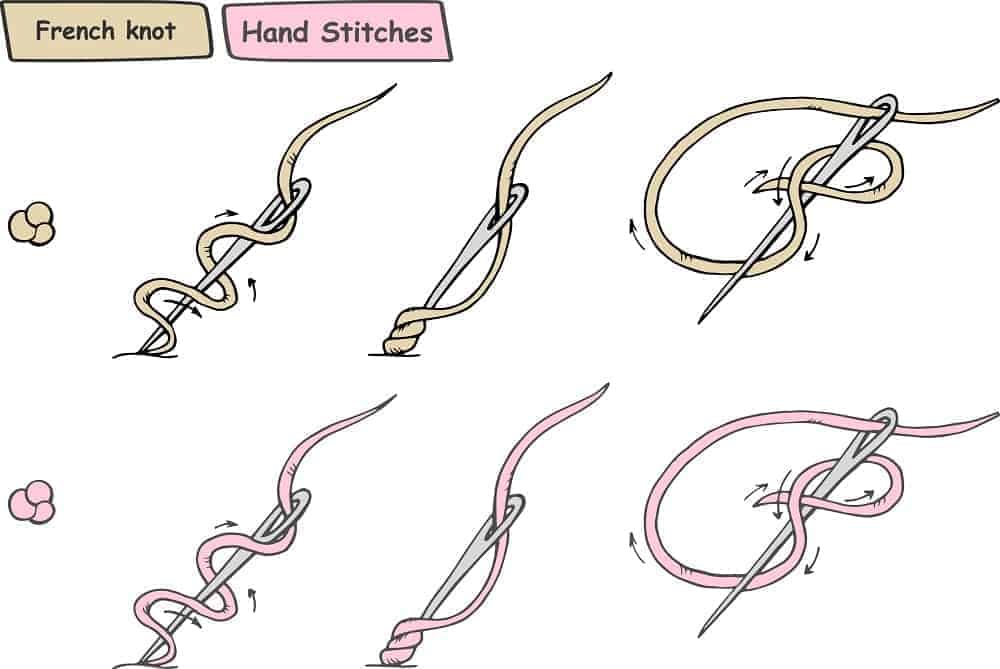
The French knot stitch looks like a knot and is used to create fine details in embroidery. It’s often used for eyes or to fill in the middle of designs or shapes that are round.
Chain Stitch
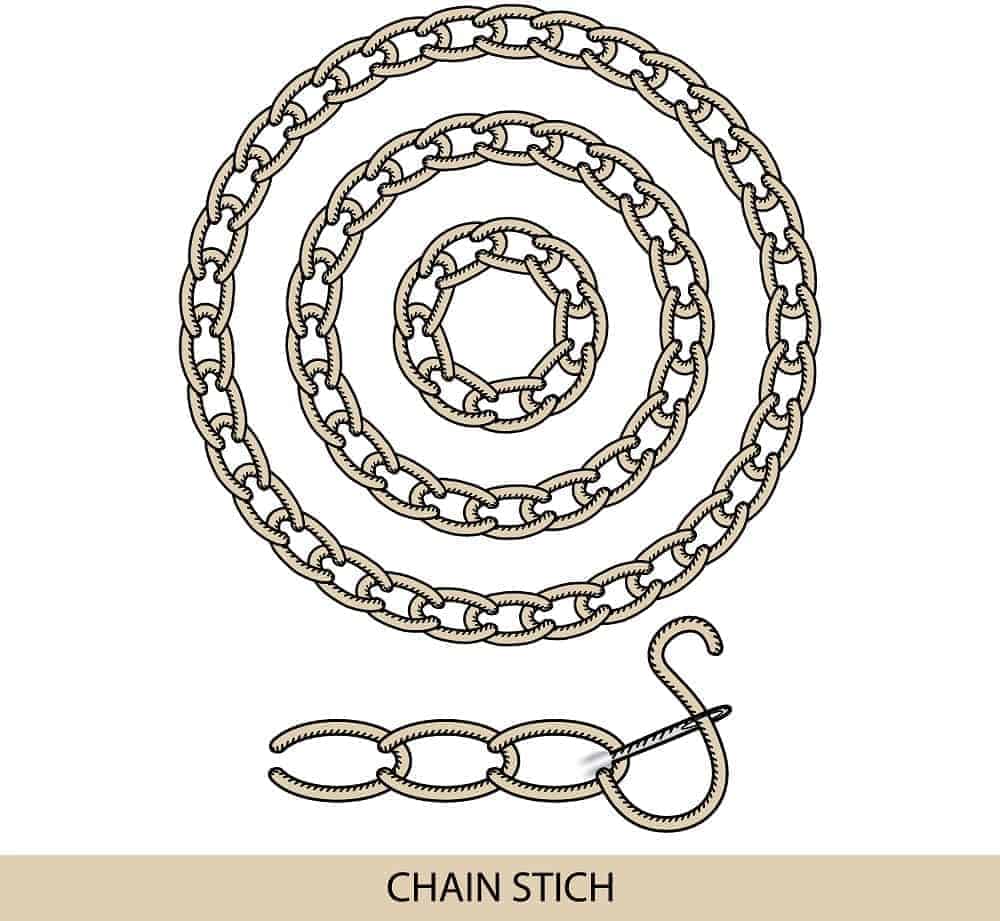
Creating a chain-like pattern, the chain stitch is a basic technique and uses a series of looped stitches. This can be used for both curved or straight lines.
Feather Stitch
A very attractive stitch, the feather stitch is also known as the single coral stitch. It’s easy and looks very nice when done well.
Lazy Daisy Stitch
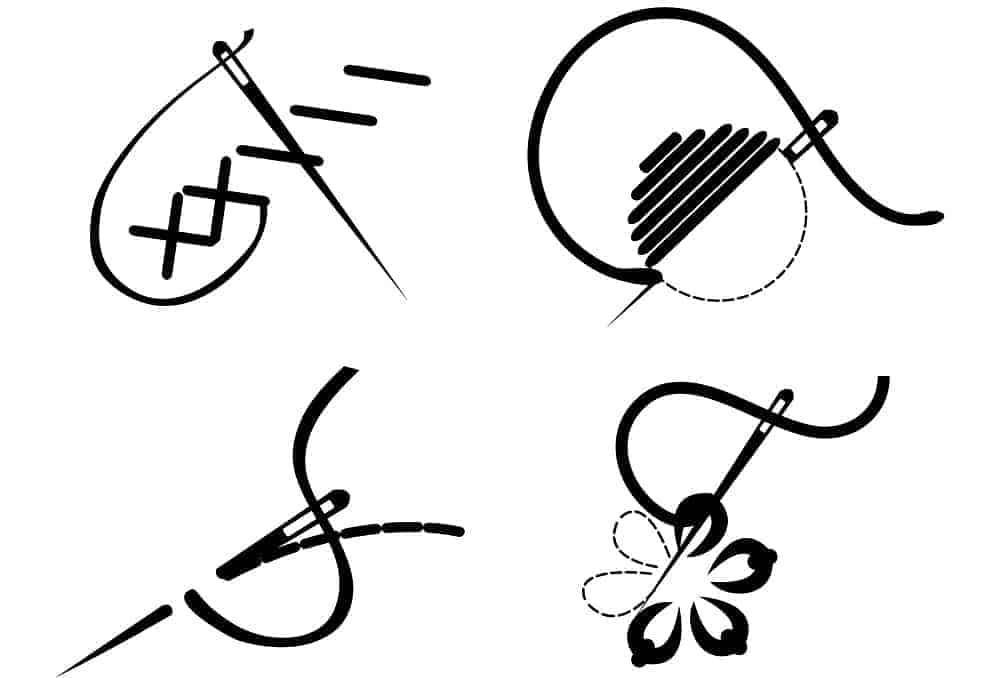
Used to make petals or other floral designs, the lazy daisy stitch is made by completing a few steps. First, you make a loop and then add a small stitch at the end of the loop. When making several of these, it creates the look of a daisy flower.
Herringbone Stitch
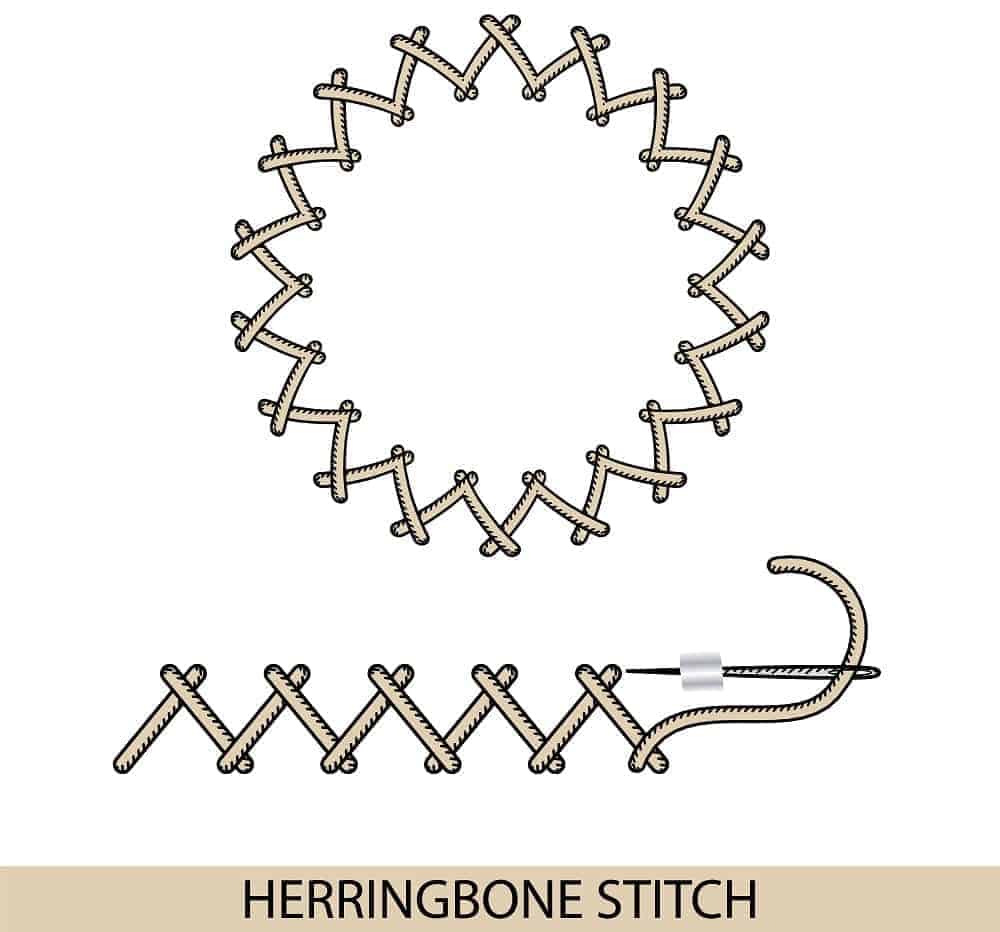
Also known as the catch stitch or plaited stitch, the herringbone stitch is used in embroidery as well as in hemming garments. Consider drawing parallel lines to ensure even spacing.
Seed Stitch
The seed stitch is considered a running stitch. It’s also known as a rice grain stitch and is done by creating a running stitch in one direction to fill in a design.
Fly Stitch
Creating a look similar to a flying bird, the fly stitch is made by creating several stitches in a row to look like flying birds. The process is similar to making a detached chain stitch, but it’s made into a “v” shape instead of a petal.
Detached Chain Stitch
Another simple way to make flower petals and leaves, the detached chain stitch is also known as the single chain stitch. It’s similar to the chain stitch, but only has one link.
Couching Stitch
The couching stitch is a little trickier because it uses two strands of thread at the same time. One thread is on the surface of the fabric and the other holds it in place by using tacking stitches.
Woven Wheel Stitch
Also known as the woven rose stitch, the woven wheel stitch is lovely. It may look complicated, but it’s just made by first creating a star of stitches with your needle and thread and then working the thread through to form a flower.
Blanket Stitch

Used to make a border or decorative edge, the blanket stitch can be used as a decorative frame. It can also be used on the sides of a fabric hem. Variation can be added by changing the length and distance of the stitches.
Bullion Knot
A must-know stitch for those who produce roses on their work, the bullion knot, or bullion stitch, is an advanced embroidery stitch. It consists of multiple steps, including a basic center, French knot, and then bullion knots.
Sewing Machine Stitches
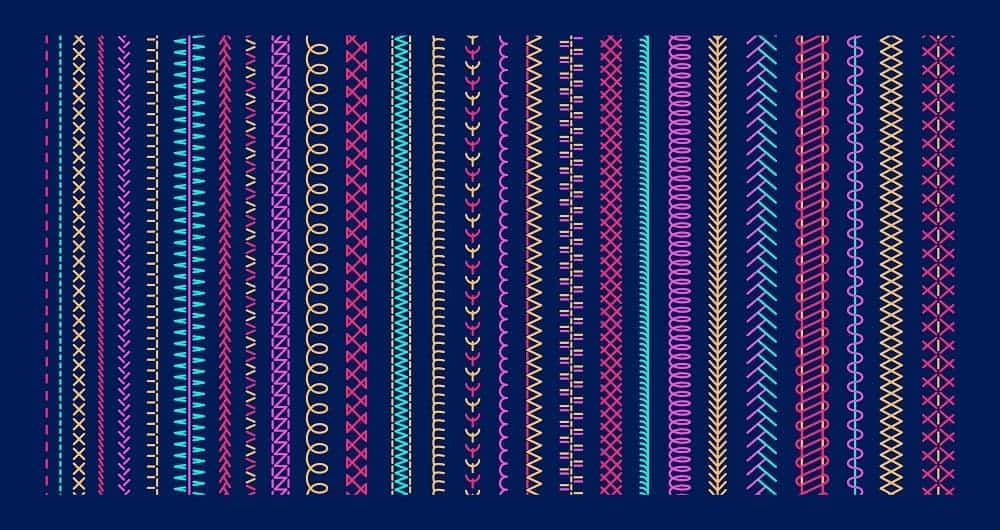
Sewing machines offer a huge number of types of stitches. In some instances, the machine that offers the most stitches may seem like the best value. This could be the case if you are creative in your sewing and make good use of your machine. Here is a look at the possibilities when it comes to stitches offered by sewing machines.
Straight Stitch
The most common machine stitch, sewing machines also include the straight stitch. With a machine, you can adjust the stitch length and keep everything uniform.
Reverse Straight Stitch
The reverse straight stitch is used as an anchor stitch. Machines will sew the straight or zigzag stitch backward and use anchor stitches to help to keep seams from unraveling.
Basting Stitches
By increasing the stitch length for a straight stitch, you can create basting or gathering stitches. These can be up to two inches long.
Satin Stitch
A closely made zigzag stitch, the satin stitch is used to make buttonholes, as a decorative stitch, to sew appliques, and finish edges.
Zigzag Stitch
This stitch looks just as it sounds and forms a zigzag line. To make this stitch, the pressure foot will need a wider hole than the one used for a straight stitch. The most common use for a zigzag stitch is to neaten up the edges of cut fabric.
Stretch Stitch
Used to stitch knit fabrics, the stretch stitch is a narrow zigzag stitch. This stitch is also called the lightning stitch or elastic stitch and allows the fabric to continue to stretch. A regular straight stitch will break if a fabric stretches, but not the stretch stitch.
Edge Stitching
The edge stitch uses an edge presser foot to make a straight stitch along the edge of the fabric.
Rolled Edge Stitch
Used to create rolled edges of cut fabric, the rolled edge stitch is made by using a special foot called the hemmer foot.
Triple Straight Stitch
Great for many uses, the triple straight stitch is made by completing a pattern that is two steps forward, one step back. Also known as the back stitch or triple stretch stitch, it’s used to make extremely strong seams in fabrics that are stretchy.
Coverstitch
Most often used in garments that are ready to wear, the cover stitch includes straight, parallel rows of stitching on the front of the garment and zigzag stitching on the back. There is a special coverstitch machine, but the effect can be done on a regular sewing machine with double needles.
Buttonhole Stitch
Some machines have a one-step buttonhole stitch, while others come with a two-step version, If your machine does not have either type, you can manually adjust your zigzag machine to sew buttonholes.
Blind Hem Stitch
Used to hem fabric without noticeable stitching on the front, the blind hem stitch simply leaves small dots on the surface of the garment. Some machines also include a blind hem stitch for fabrics with stretch.
Scallop Stitch
A difficult stitch to master, the scallop stitch makes scallop shapes. There are a few methods to make scalloped edges in addition to this stitch if it’s too tricky.
Shell Tuck Stitch
With an eye-pleasing design, the shell tuck stitch makes nice shell tucks along the edge of the fabric.
Overcasting Stitch
The overcasting stitch is another nice method used for making the edges of fabric look neat. Use an overcast presser foot to make this stitch.
Insertion Stitch
Also known as the faggoting stitch or cross stitch, this method joins two pieces of fabric together. If the fabric is stretchy, it can be joined in an abutting seam.
Ladder Stitch
The ladder stitch makes a nice channel for elastic or ribbon to be inserted. It’s also known as a rampart stitch.
Multi-step Zigzag Stitch
A more complicated stitch, the multi-step zigzag stitch is another one used to finish the edge of fabrics. It can be used as an insertion stitch.
Overlock Stitch
A combination of a zigzag and straight stitch, the overlock stitch sews both forward and backward. It creates the look of serging, which is the method used for sewing store-bought clothing, so it can make your clothing items look professionally finished.
Lock Stitch
The lock stitch is available on sewing machines as a way to secure stitches without needing to back stitch. It loops together with the ends of two threads, one on each side of the material.
Decorative Stitches
Some, but not all sewing machines have the capability of creating a decorative stitch, or several decorative stitches. These can embellish projects and will need some practice to create. Make sure you have a sturdy thread and take your time.
FAQs
What is a stitch in clothing?
A stitch is a loop or single turn of yarn or thread.
What are the three basic stitches?
If you are new to sewing, the most basic stitches to learn are the straight/running stitch, the backstitch, and the basting stitch. These will give you a great place to start and a nice foundation to build on.
How do you start and end a stitch?
There are a few different methods of starting and ending a stitch. Anchor your thread by using a waste knot, the “L” technique, or an away knot. When ending your thread, bring the thread to the underside of the fabric. Run the needle under a few stitches to secure the thread. If necessary, run it back again in the opposite direction.
How can you learn stitches at home?
We currently live in the age of online tutorials. There are amazing videos available on YouTube that can teach you nearly any stitch. Also, don’t forget about friends or family members who can sew. Invite an avid seamstress over for dinner and ask for a lesson after the meal. Some fabric/crafting stores also offer classes if you are willing to venture out.
How do you choose a sewing machine?
- Think about your reasons for sewing. Will the machine be used for crafting, making or mending clothing, quilting, embroidery, making drapes, or something else?
- Consider your purpose and how much time you will spend using the machine to come up with a budget.
- Do the research and compare machines in your price range that can perform the functions that you need.
- Narrow down your choices and head to a sewing shop. Ask to see demonstrations of the machines and ask the sales professional for their advice.
- Decide and make your purchase.
Which is stronger straight or zigzag stitch?
The straight stitch is considered the strongest stitch, but the zigzag stitch is still quite durable.
What is the best stitch to use for hemming?
If hemming knit fabric, the herringbone is the best choice because it allows for some flexibility in the hem. If flexibility is not important, the blanket stitch looks very nice when used for hemming.
How are stitch counts estimated?
Most embroidery projects are priced by a cost per thousand stitches. To estimate the stitch count, there are three things that are taken into consideration. Filled in blocks of the colored area have about 1,250 stitches per inch.
Satin, or column stitches, which are usually used for making letters or wide borders, usually have 100 stitches per 1/4 inch. Running stitches, which are used for outlining small elements, generally include about 50 stitches per linear inch.
References:
Kresent! Health and Lifestyle: Types Of Hand Stitches (9 Basic Hand Stitches With Steps)
Sewing.com: 17 Hand Embroidery Stitches Every Sewer Should Know
Sew Guide: 20 Basic {Sewing Machine Stitches} you need to know about


